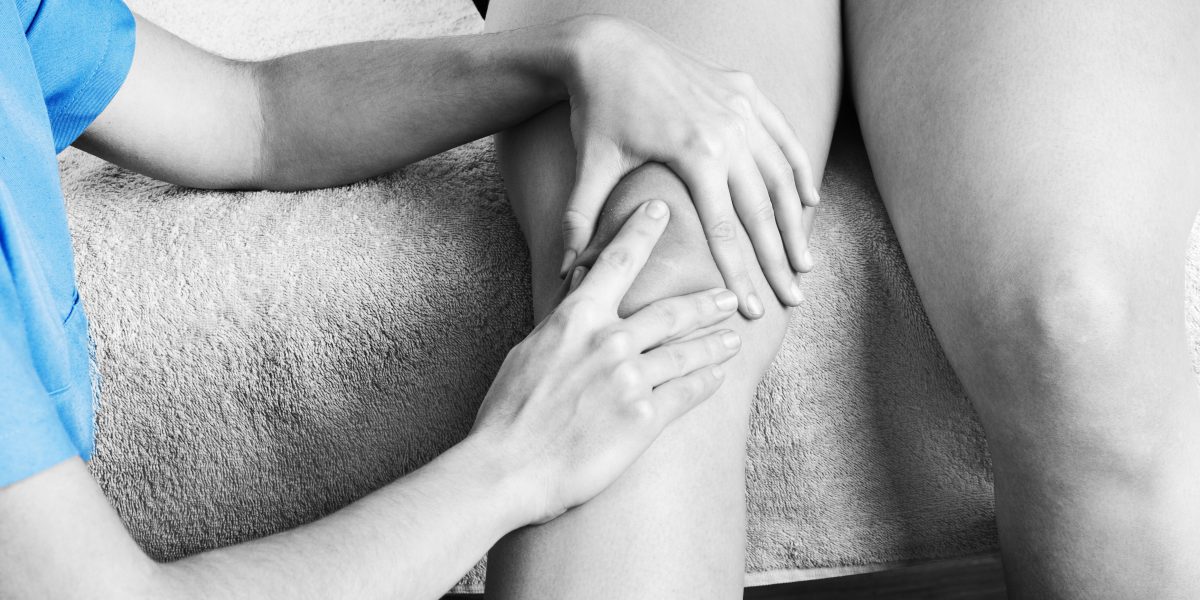Patellar tendinosis is a frequent problem for athletic people. It is usually caused by repeated stress from running and jumping. High volume squats, like those in many WODs at HIIT and cross training boxes, are a common cause too. To help athletes avoid problems and stay in the gym, we’ve written about common HIIT injuries. You can learn how to avoid and treat the most common problems here. But this post was written to help you understand how to treat patellar tendinosis.
What is Patellar Tendinosis?
Tendinosis is an accumulation of damage from everyday activities. When you jump, run, and squat you add extra damage to the patellar tendon. If you do more damage than you can heal, you’ll eventually accumulate enough to cause problems. After a while, this leads to pain, swelling, and more swearing than usual at the end of a WOD.
You may also hear the terms patellar tendinitis and patellar tendinopathy. While these different ways that the problems develop they are interchangeable for our purposes. Don’t get hung up on the details!
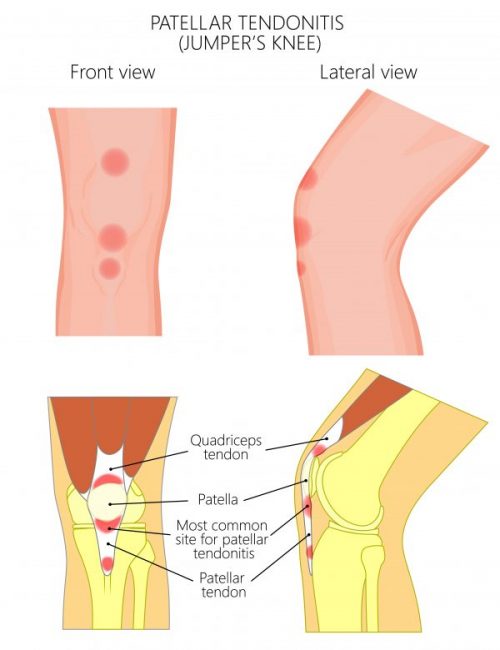
Anatomy of the Patellar Tendon
The patellar tendon runs from the bottom of your kneecap down to the bump on the top of your shin. It is what connects your quadriceps to your shin bone. The patellar tendon allows the quads to act on your knee, extending it out straight. Because of this, the tendon will be stressed by activities which require a lot of quad activity like jumping. In fact, this is often called Jumper’s Knee.
Causes of Patellar Tendinosis
Frequent ballistic exercises often lead to patellar tendinitis. WODs and HIIT classes often program low-weight high-volume exercises that strain the patellar tendon. MetCon’s with 40+ box jumps and thrusters come to mind! On the other hand, heavy work like slow, powerful squats doesn’t usually cause this problem. So programming that varies the workload can help prevent patellar tendinitis before it starts.
Treatment of Patellar Tendinosis
Nonsurgical treatments methods are usually successful. The following treatments can cure patellar tendinosis more than 70% of the time. Many of them can be done at home. Some require the help of a therapist or physician. But all require some modification to the way you exercise.
Patellar Tendinosis Treatment: Eccentric Exercise
“Whaaaat? I got hurt by exercising and yet the solution is… more exercise?” Weird but true. The difference comes in the TYPE of exercise you do. You have to stop doing the high volume ballistics and plyometrics; honestly stop them. At least for the short term. You need to give your body time to heal. Instead, focus on the kind of exercise that helps lengthen muscles and helps tendon healing: Eccentrics.
Patellar tendinitis rehab focuses on eccentric exercise of the quadriceps. Eccentric quad exercise is the “negative” part of a squat, where you are slowly lowering to the ground. (The part where you push back up to standing is called “concentric.”) Eccentric exercise is the best-known way to treat patellar tendinosis. But it is still only effective about 60-70% of the time.
If you want to know more about eccentric exercise, be sure to subscribe to our weekly blog updates. It’s very easy: just put your email in the little blue box on this page. You’ll get our weekly blog straight to your in-basket, no spam.
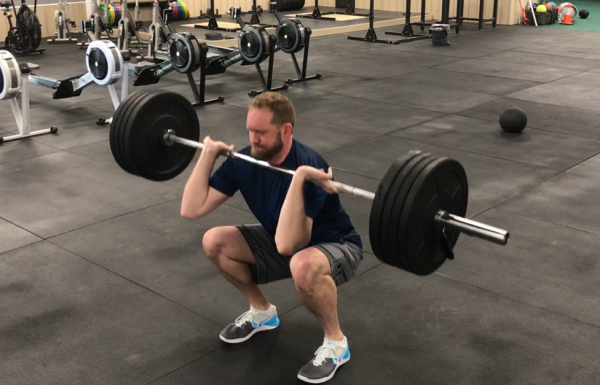
Patellar Tendinosis Treatment: Hamstring Stretching
Hamstring stretching has long been a key part of rehab for anterior knee pain including patellar tendinitis. We know that tight hamstrings and anterior knee pain go hand in hand, but still, this is more correlation than causation. But in the office, I see that improvements in hamstring flexibility correspond with improvements in knee pain. My theory is that tight hamstrings are like driving around with your emergency brake on two clicks. You can get where you’re going, but something will be smoking by the time you get there!
As you’ll see in another post on eccentric exercise, coming soon, eccentric exercises help to lengthen muscles. So stretching will naturally occur with that treatment, but a little assistance doesn’t hurt.
Patellar Tendinosis Treatment: Foam Rolling
Foam rolling is a new but helpful way to loosen and relax overworked muscles. Foam rolling is also known as self-myofascial release. We need more scientific research about foam rolling, for sure. But what we do see is quite promising. It seems to help muscles by stimulating reflexive nerve fibers that loosen and relax the muscles. In many ways, it seems to be superior to standard stretching.
Tightness in both the quads and hamstrings are known risk factors for patellar tendinosis. So I suggest rolling both sets of muscles. Unfortunately, I couldn’t find any studies evaluating the benefits of foam rolling for patellar tendinitis! For now, we’ll have to rely on reasoning alone.
Patellar Tendinosis Treatment: Patellar Tendon Brace
Bracing is often used to help with the pain of patellar tendinosis. You see these little straps just below the kneecap of many basketball players. The patellar tendon brace changes which parts of the tendon see the most strain during activity. It also improves the way people jump and land. This results in less stress on the tendon and less pain. However, I couldn’t find any studies that evaluated whether or not the use of a patellar tendon strap helps the tendon to heal faster.
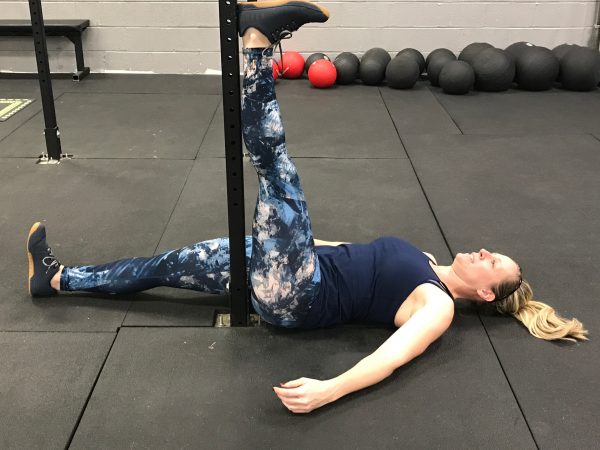
Patellar Tendinosis Treatment: Extracorporeal Shockwave Therapy
This is a treatment modality performed by a physical therapist. It’s one of the reasons I tell patients “If therapy was simply watching you exercise, it wouldn’t take four years to get the degree.” Like most of the treatments beyond eccentric exercise, it improves the response rate to treatment, but only by a small amount. That’s why it’s reserved until after the usual three months of standard therapy.
How does ECSW work? Well, you see… we aren’t exactly sure. But we do know that stem cells in a lab grow into tendon cells if they are flexed and stretched. And there are stem cells around most blood vessels in your body. So as new vessels grow into the tendon during healing, maybe the shockwave promotes tendon cells to grow from those stem cells? But who knows? I’ve been wrong before. We’ll have to wait for further research to learn more.
Patellar Tendinosis Treatment: Nitroglycerin Patches
There was a love affair with nitroglycerin patch treatment for tendonitis a while back. These are the same nitro patches help people with clogged arteries around the heart. They releasing nitrous oxide into the body. This is a chemical that your body already uses to dilate blood vessels and increase blood flow. And it is found at higher concentrations in damaged tendons.
This made physicians think that applying nitro patches to the patellar tendon could bring extra blood flow and help them heal. The initial caused a lot of excitement. But like many animal studies, it didn’t translate directly to humans as well as hoped. There seems to be some small benefit to using them, but not as great as previously thought. Similar to ECSW treatment, we use nitro patches when standard treatments have failed.
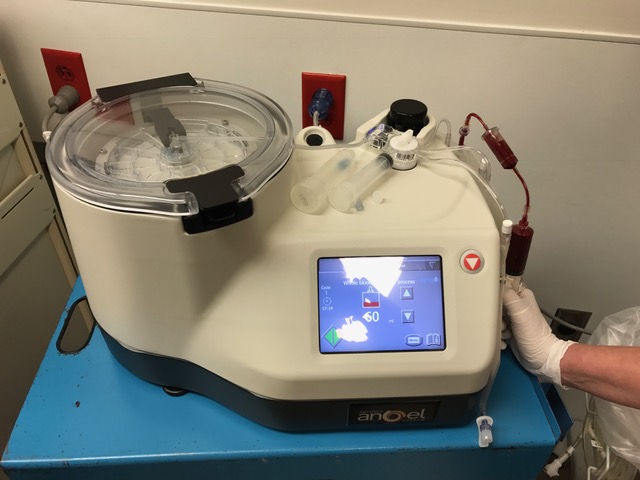
Patellar Tendinosis Treatment: PRP injections and Stem Cell Injections
Since this article was originally published, there are updated studies regarding PRP and Stem Cell Injections. Check out Dr. Larson’s opinion based on these studies and our in-clinic results here!
The results of an aggregate meta-analysis on PRP injections showed the staggering lack of solid scientific study about this treatment method. The review that I cite below only found TWO reliable studies to assess PRP treatment with. That was out of hundreds of published studies. The others were not rigorous enough. This usually means that they lacked a control or placebo group or other such flaws that decreases their scientific value.
However, the data from those two studies indicated that PRP appears to be a better treatment method than ECSW. But again, that’s limited data. So I usually put this in the same category as ECSW and Nitro patches. They give us something to try when nothing else works. And sometimes they seem to get results!
Stem cells are in a similar situation. While there have been studies that show improvements in tendinitis with stem cell injections, they don’t compare results to other treatments or placebo. Right now we are in that stage of anecdotal evidence. But honestly, the improvements I see in patients after stem cell injections have been remarkable. Harvesting the cells from bone marrow and then injecting them into the tendon is usually done as an outpatient procedure. But it has resulted in some of the fastest recoveries I have personally seen in rotator cuffs and Achilles tendon problems.
Patellar Tendinosis Treatment: Surgery
Surgery, as usual, is the last resort. There are effective surgical treatments for patellar tendonitis. So why is surgery a last resort? Glad you asked! First, it’s got about the same rate of healing as basic eccentric exercise. The most recent review showed a 77% success rate. Second, recovery afterward takes several months just like eccentric exercise. Third, it’s expensive and has risks from anesthesia and infection.
Surgery for patellar tendinitis can be performed with a larger incision or with arthroscopic techniques. The success is pretty similar either way. Some studies do show faster recovery with the arthroscopic approach though. The surgery itself involves cleaning away damaged tissue and removing any pointy portions near the bottom of the kneecap that may cause stress on the tendon. Surgery is usually done as an outpatient at a surgery center. And you are usually allowed to walk on the leg immediately after surgery.
What should I do about my knee pain?
The most important thing is to be proactive. Results of treatment are much better if you take action soon. Conversely, waiting a long time and pushing through the pain often makes the problem difficult to treat. Decrease the amount of jumping or running that you do. Work on your quad and hamstring flexibility. Drop the weight you workout with and focus on eccentric strength training. Icing your knee helps with the pain but doesn’t help you heal. Ditto for anti-inflammatories.
If those methods haven’t helped within six weeks, then get in to see a specialist. A therapist is a great place to start. But you’ll probably need to see a sports medicine physician to get a prescription for long-term therapy. Remember it can take 3-6 months on average to get relief of your symptoms, so the key to this whole process is PATIENCE.
Don’t worry. You won’t lose as much strength or endurance as you fear. If you take the time to heal and recover when injured, you’ll find that you reach your goals faster than if you try to push through the pain. Professionals push through the pain when competing. That doesn’t mean you should do it when training.
Works Cited
- Dupley, Leanne, and Charalambos P. Charalambous. “Platelet-Rich Plasma Injections as a Treatment for Refractory Patellar Tendinosis: A Meta-Analysis of Randomised Trials.” Knee Surgery
- Everhart, Joshua S., et al. “Treatment Options for Patellar Tendinopathy: A Systematic Review.” Arthroscopy: The Journal of Arthroscopic & Related Surgery 2017
- Khan, W S, and A Smart. “Outcome of Surgery for Chronic Patellar Tendinopathy: A Systematic Review.” 2016
- Rosen, A B, et al. “Single-Limb Landing Biomechanics Are Altered and Patellar Tendinopathy Related Pain Is Reduced with Acute Infrapatellar Strap Application.” The Knee 2017
- Witvrouw, E, et al. “Intrinsic Risk Factors for the Development of Patellar Tendinitis in an Athletic Population. A Two-Year Prospective Study.” The American Journal of Sports Medicine.,
- van, D, et al. “Comparison of the Effect of 5 Different Treatment Options for Managing Patellar Tendinopathy: A Secondary Analysis.” Clinical Journal of Sport Medicine : Official Journal of the Canadian Academy of Sport Medicine.

